Leadership and Management in Operations at Barclays: Report
VerifiedAdded on 2021/01/01
|21
|6171
|110
Report
AI Summary
This report delves into the core concepts of leadership and management within the context of operations management. It begins by differentiating between the roles of leaders and managers, exploring key theories such as J. Kotter's distinctions, Peter Drucker's Management by Objectives, and H. Mintzberg's three management roles. The report also analyzes trait theory of leadership, explores different leadership styles, and discusses the importance of both hard management skills and soft leadership skills. Furthermore, it examines transformation processes, the concept of quality, and approaches like Total Quality Management and Just-in-Time. The second part of the report applies these concepts to Barclays, a multinational investment bank, analyzing the management team's strengths, weaknesses, and operational recommendations. The report concludes with an evaluation of leadership and management in a contemporary business environment, providing insights into how these principles contribute to organizational success.
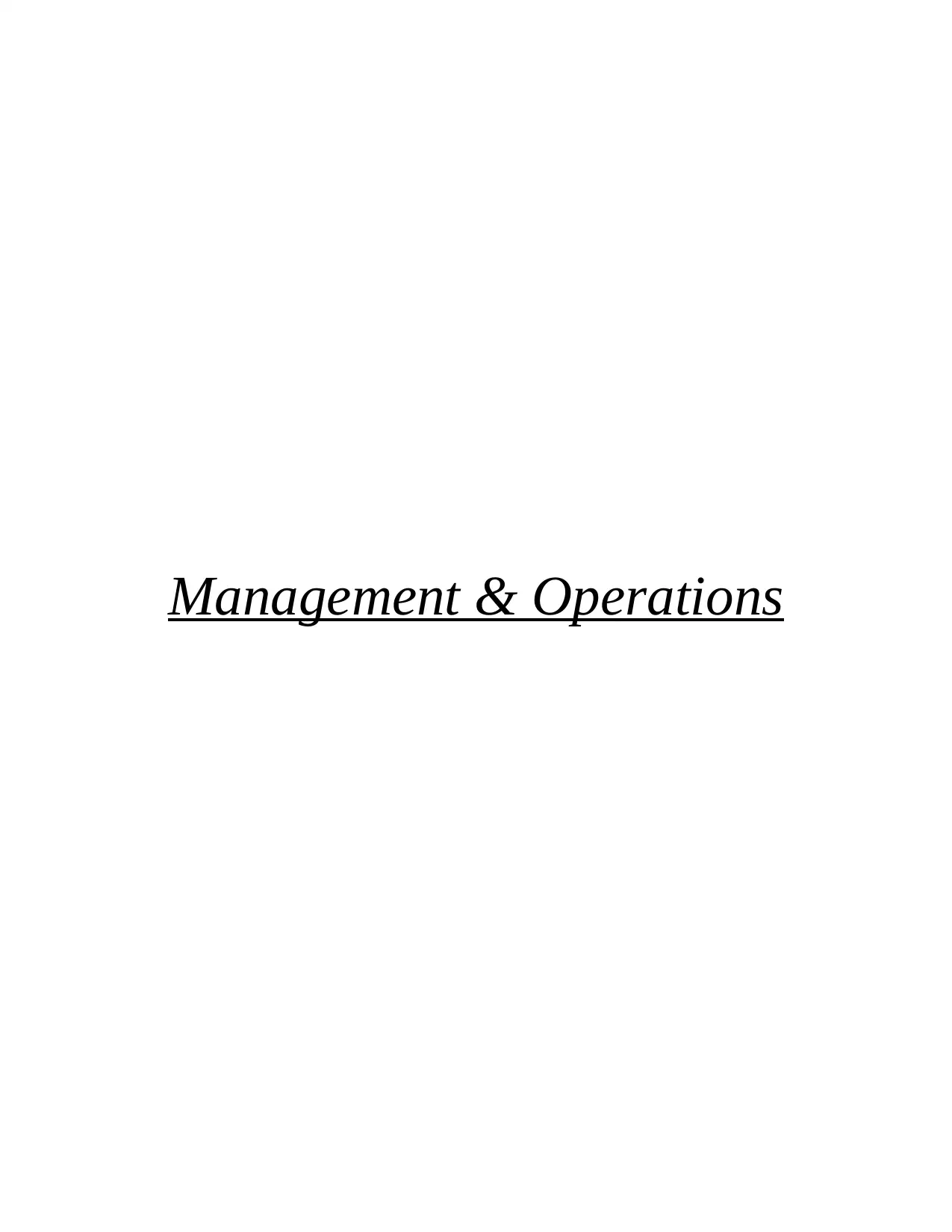
Management & Operations
Paraphrase This Document
Need a fresh take? Get an instant paraphrase of this document with our AI Paraphraser
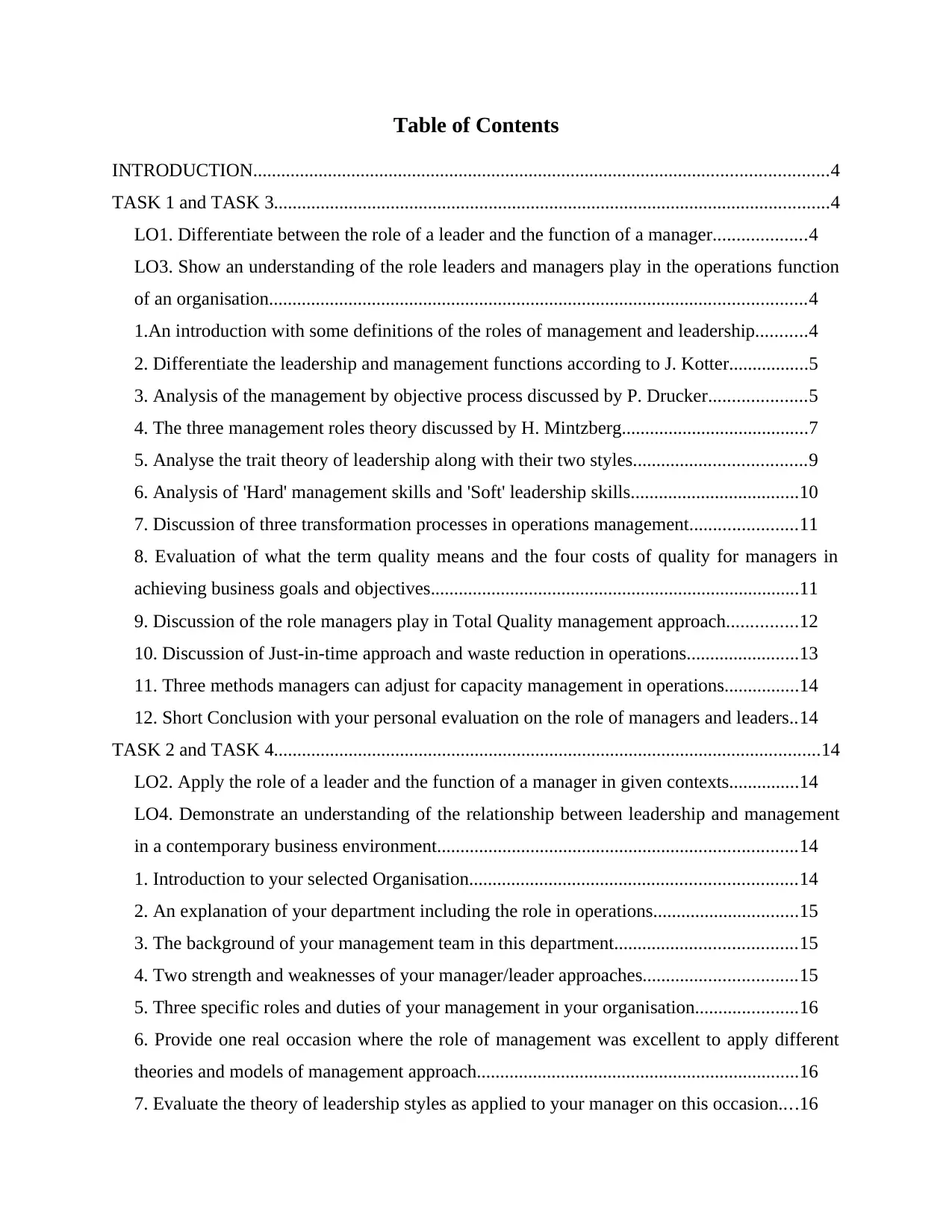
Table of Contents
INTRODUCTION...........................................................................................................................4
TASK 1 and TASK 3.......................................................................................................................4
LO1. Differentiate between the role of a leader and the function of a manager....................4
LO3. Show an understanding of the role leaders and managers play in the operations function
of an organisation...................................................................................................................4
1.An introduction with some definitions of the roles of management and leadership...........4
2. Differentiate the leadership and management functions according to J. Kotter.................5
3. Analysis of the management by objective process discussed by P. Drucker.....................5
4. The three management roles theory discussed by H. Mintzberg........................................7
5. Analyse the trait theory of leadership along with their two styles.....................................9
6. Analysis of 'Hard' management skills and 'Soft' leadership skills....................................10
7. Discussion of three transformation processes in operations management.......................11
8. Evaluation of what the term quality means and the four costs of quality for managers in
achieving business goals and objectives...............................................................................11
9. Discussion of the role managers play in Total Quality management approach...............12
10. Discussion of Just-in-time approach and waste reduction in operations........................13
11. Three methods managers can adjust for capacity management in operations................14
12. Short Conclusion with your personal evaluation on the role of managers and leaders..14
TASK 2 and TASK 4.....................................................................................................................14
LO2. Apply the role of a leader and the function of a manager in given contexts...............14
LO4. Demonstrate an understanding of the relationship between leadership and management
in a contemporary business environment.............................................................................14
1. Introduction to your selected Organisation......................................................................14
2. An explanation of your department including the role in operations...............................15
3. The background of your management team in this department.......................................15
4. Two strength and weaknesses of your manager/leader approaches.................................15
5. Three specific roles and duties of your management in your organisation......................16
6. Provide one real occasion where the role of management was excellent to apply different
theories and models of management approach.....................................................................16
7. Evaluate the theory of leadership styles as applied to your manager on this occasion....16
INTRODUCTION...........................................................................................................................4
TASK 1 and TASK 3.......................................................................................................................4
LO1. Differentiate between the role of a leader and the function of a manager....................4
LO3. Show an understanding of the role leaders and managers play in the operations function
of an organisation...................................................................................................................4
1.An introduction with some definitions of the roles of management and leadership...........4
2. Differentiate the leadership and management functions according to J. Kotter.................5
3. Analysis of the management by objective process discussed by P. Drucker.....................5
4. The three management roles theory discussed by H. Mintzberg........................................7
5. Analyse the trait theory of leadership along with their two styles.....................................9
6. Analysis of 'Hard' management skills and 'Soft' leadership skills....................................10
7. Discussion of three transformation processes in operations management.......................11
8. Evaluation of what the term quality means and the four costs of quality for managers in
achieving business goals and objectives...............................................................................11
9. Discussion of the role managers play in Total Quality management approach...............12
10. Discussion of Just-in-time approach and waste reduction in operations........................13
11. Three methods managers can adjust for capacity management in operations................14
12. Short Conclusion with your personal evaluation on the role of managers and leaders..14
TASK 2 and TASK 4.....................................................................................................................14
LO2. Apply the role of a leader and the function of a manager in given contexts...............14
LO4. Demonstrate an understanding of the relationship between leadership and management
in a contemporary business environment.............................................................................14
1. Introduction to your selected Organisation......................................................................14
2. An explanation of your department including the role in operations...............................15
3. The background of your management team in this department.......................................15
4. Two strength and weaknesses of your manager/leader approaches.................................15
5. Three specific roles and duties of your management in your organisation......................16
6. Provide one real occasion where the role of management was excellent to apply different
theories and models of management approach.....................................................................16
7. Evaluate the theory of leadership styles as applied to your manager on this occasion....16
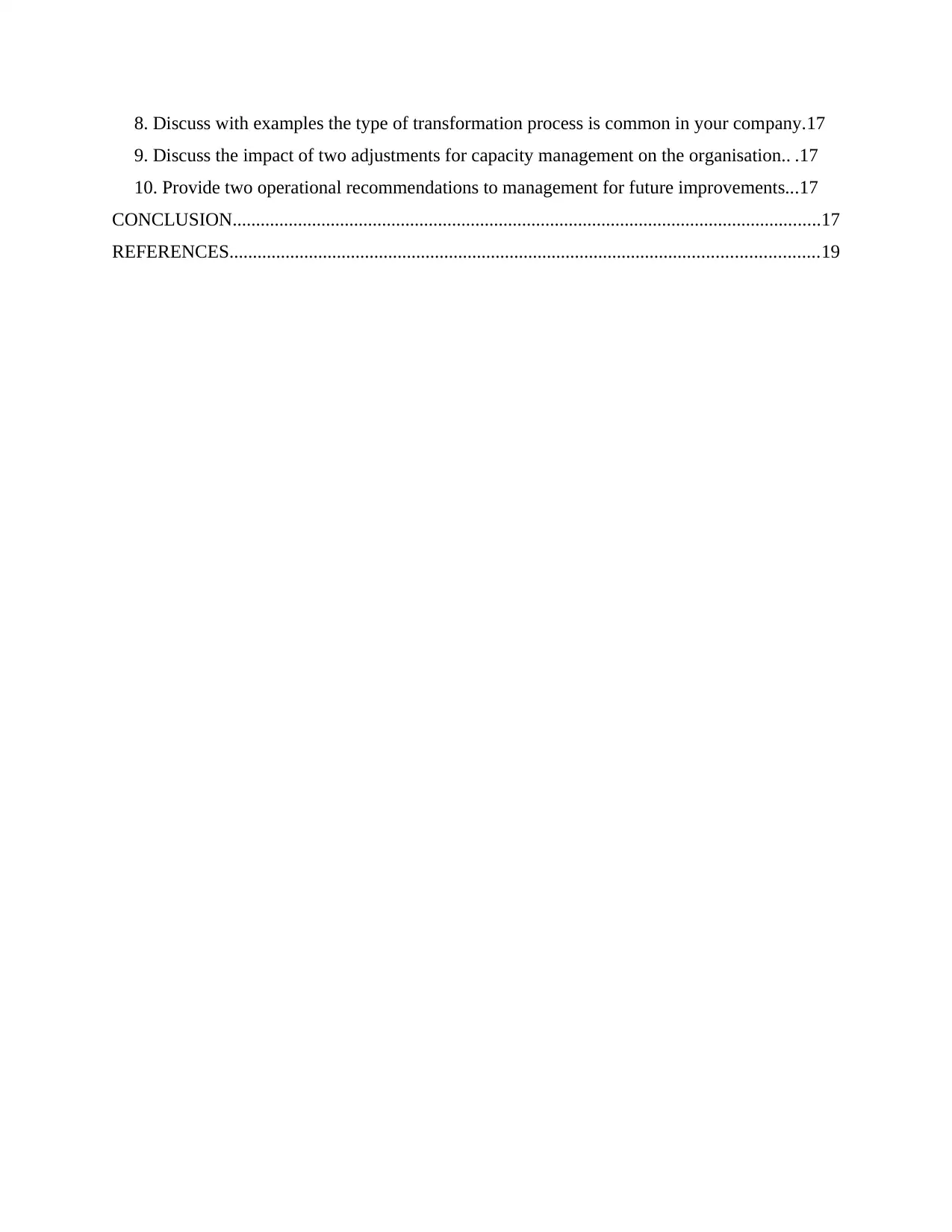
8. Discuss with examples the type of transformation process is common in your company.17
9. Discuss the impact of two adjustments for capacity management on the organisation.. .17
10. Provide two operational recommendations to management for future improvements...17
CONCLUSION..............................................................................................................................17
REFERENCES..............................................................................................................................19
9. Discuss the impact of two adjustments for capacity management on the organisation.. .17
10. Provide two operational recommendations to management for future improvements...17
CONCLUSION..............................................................................................................................17
REFERENCES..............................................................................................................................19
⊘ This is a preview!⊘
Do you want full access?
Subscribe today to unlock all pages.

Trusted by 1+ million students worldwide
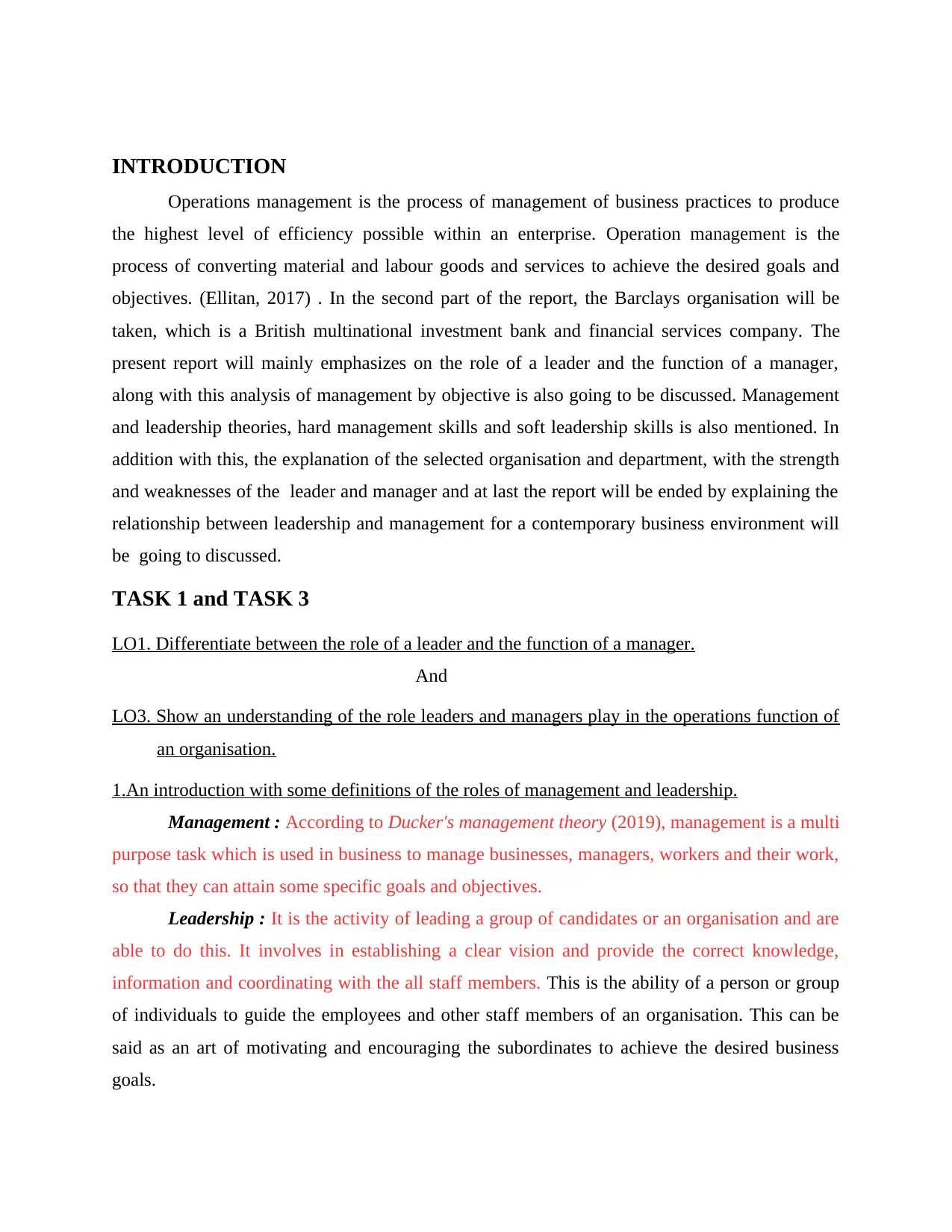
INTRODUCTION
Operations management is the process of management of business practices to produce
the highest level of efficiency possible within an enterprise. Operation management is the
process of converting material and labour goods and services to achieve the desired goals and
objectives. (Ellitan, 2017) . In the second part of the report, the Barclays organisation will be
taken, which is a British multinational investment bank and financial services company. The
present report will mainly emphasizes on the role of a leader and the function of a manager,
along with this analysis of management by objective is also going to be discussed. Management
and leadership theories, hard management skills and soft leadership skills is also mentioned. In
addition with this, the explanation of the selected organisation and department, with the strength
and weaknesses of the leader and manager and at last the report will be ended by explaining the
relationship between leadership and management for a contemporary business environment will
be going to discussed.
TASK 1 and TASK 3
LO1. Differentiate between the role of a leader and the function of a manager.
And
LO3. Show an understanding of the role leaders and managers play in the operations function of
an organisation.
1.An introduction with some definitions of the roles of management and leadership.
Management : According to Ducker's management theory (2019), management is a multi
purpose task which is used in business to manage businesses, managers, workers and their work,
so that they can attain some specific goals and objectives.
Leadership : It is the activity of leading a group of candidates or an organisation and are
able to do this. It involves in establishing a clear vision and provide the correct knowledge,
information and coordinating with the all staff members. This is the ability of a person or group
of individuals to guide the employees and other staff members of an organisation. This can be
said as an art of motivating and encouraging the subordinates to achieve the desired business
goals.
Operations management is the process of management of business practices to produce
the highest level of efficiency possible within an enterprise. Operation management is the
process of converting material and labour goods and services to achieve the desired goals and
objectives. (Ellitan, 2017) . In the second part of the report, the Barclays organisation will be
taken, which is a British multinational investment bank and financial services company. The
present report will mainly emphasizes on the role of a leader and the function of a manager,
along with this analysis of management by objective is also going to be discussed. Management
and leadership theories, hard management skills and soft leadership skills is also mentioned. In
addition with this, the explanation of the selected organisation and department, with the strength
and weaknesses of the leader and manager and at last the report will be ended by explaining the
relationship between leadership and management for a contemporary business environment will
be going to discussed.
TASK 1 and TASK 3
LO1. Differentiate between the role of a leader and the function of a manager.
And
LO3. Show an understanding of the role leaders and managers play in the operations function of
an organisation.
1.An introduction with some definitions of the roles of management and leadership.
Management : According to Ducker's management theory (2019), management is a multi
purpose task which is used in business to manage businesses, managers, workers and their work,
so that they can attain some specific goals and objectives.
Leadership : It is the activity of leading a group of candidates or an organisation and are
able to do this. It involves in establishing a clear vision and provide the correct knowledge,
information and coordinating with the all staff members. This is the ability of a person or group
of individuals to guide the employees and other staff members of an organisation. This can be
said as an art of motivating and encouraging the subordinates to achieve the desired business
goals.
Paraphrase This Document
Need a fresh take? Get an instant paraphrase of this document with our AI Paraphraser

Characteristics of leadership : Honesty and integrity- The good quality of leadership is unquestionably integrity, without
it no real success is possible in a organisation.
Confidence- To be an effective leaders confidence is very much necessary aspects where,
leaders motivate their employees in a effective manner.
2. Differentiate the leadership and management functions according to J. Kotter.
According to J. Kotter, leadership and management are not the same things. Leadership
focus on creating the change through vision. On the other hand, management focuses on creating
a state through processes.
Management Leadership
1. The management function is
Planning and budgeting (Denhardt and
Denhardt, 2015).
1. In context with this, the leadership function
is establishing the direction (Boyd and
Dougherty, 2016).
2. The management function is to
organize the work in an systematic
manner and also recruit and select a
right person for a right job which
means staffing (Ellitan, 2017).
2. In context with organizing and staffing, the
leadership function is to aligning peoples
( Doppelt, 2017).
3. The another function of management
is controlling and solving the problem
of their subordinates ( Wensveen,
2018).
3. In the similar way, the leadership function is
to motivate and inspire their subordinates
( Eraki, 2015).
4. The management function is to
produce predictability and consistency(
Fan, Liu and Zhang, 2015).
4. The leadership function is to produce useful,
sudden and drastic change( Mendenhall and et.
al, 2017).
3. Analysis of the management by objective process discussed by P. Drucker.
Management By Objectives is a performance management approach in which a balance is
required between the objectives of organisation and the objectives of employees. According to
it no real success is possible in a organisation.
Confidence- To be an effective leaders confidence is very much necessary aspects where,
leaders motivate their employees in a effective manner.
2. Differentiate the leadership and management functions according to J. Kotter.
According to J. Kotter, leadership and management are not the same things. Leadership
focus on creating the change through vision. On the other hand, management focuses on creating
a state through processes.
Management Leadership
1. The management function is
Planning and budgeting (Denhardt and
Denhardt, 2015).
1. In context with this, the leadership function
is establishing the direction (Boyd and
Dougherty, 2016).
2. The management function is to
organize the work in an systematic
manner and also recruit and select a
right person for a right job which
means staffing (Ellitan, 2017).
2. In context with organizing and staffing, the
leadership function is to aligning peoples
( Doppelt, 2017).
3. The another function of management
is controlling and solving the problem
of their subordinates ( Wensveen,
2018).
3. In the similar way, the leadership function is
to motivate and inspire their subordinates
( Eraki, 2015).
4. The management function is to
produce predictability and consistency(
Fan, Liu and Zhang, 2015).
4. The leadership function is to produce useful,
sudden and drastic change( Mendenhall and et.
al, 2017).
3. Analysis of the management by objective process discussed by P. Drucker.
Management By Objectives is a performance management approach in which a balance is
required between the objectives of organisation and the objectives of employees. According to
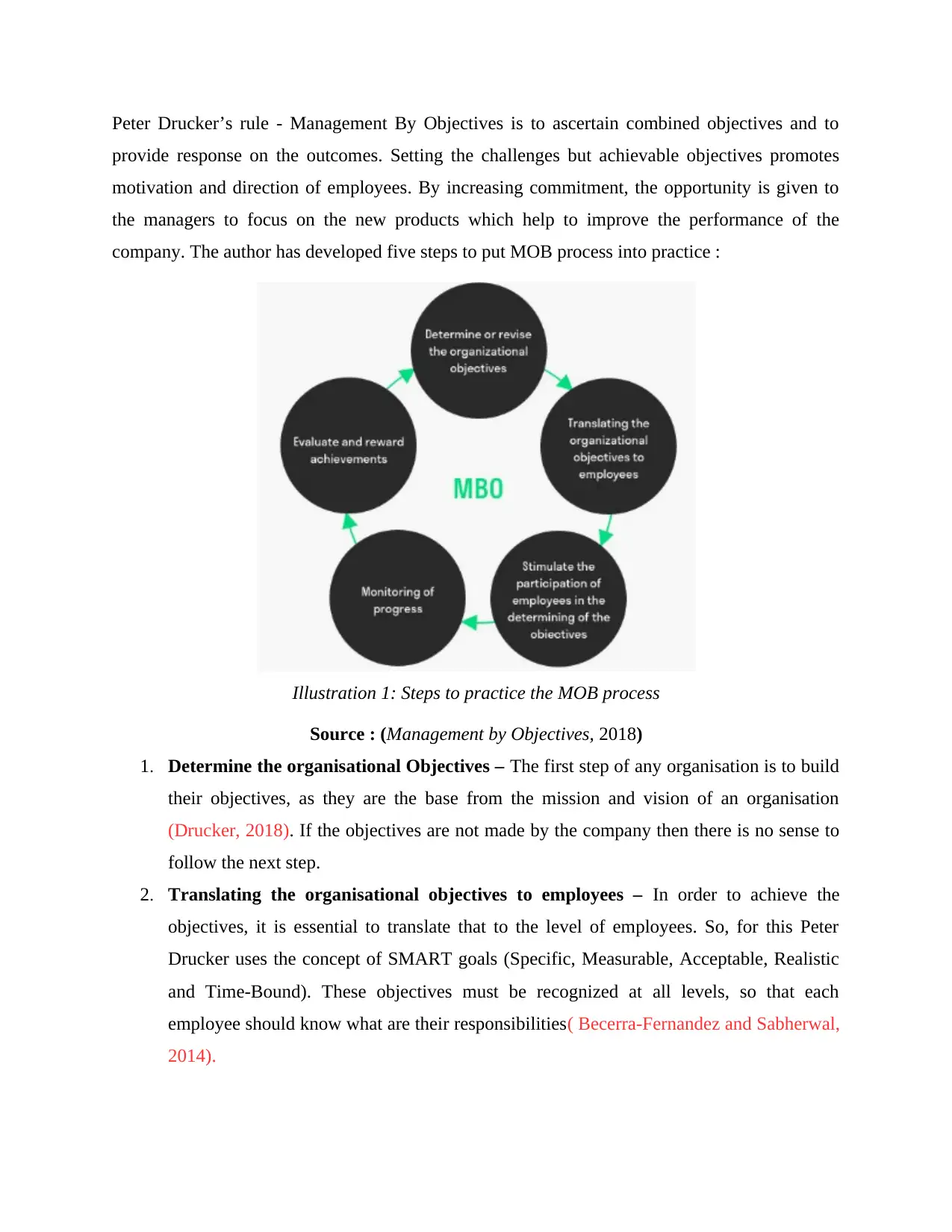
Peter Drucker’s rule - Management By Objectives is to ascertain combined objectives and to
provide response on the outcomes. Setting the challenges but achievable objectives promotes
motivation and direction of employees. By increasing commitment, the opportunity is given to
the managers to focus on the new products which help to improve the performance of the
company. The author has developed five steps to put MOB process into practice :
Source : (Management by Objectives, 2018)
1. Determine the organisational Objectives – The first step of any organisation is to build
their objectives, as they are the base from the mission and vision of an organisation
(Drucker, 2018). If the objectives are not made by the company then there is no sense to
follow the next step.
2. Translating the organisational objectives to employees – In order to achieve the
objectives, it is essential to translate that to the level of employees. So, for this Peter
Drucker uses the concept of SMART goals (Specific, Measurable, Acceptable, Realistic
and Time-Bound). These objectives must be recognized at all levels, so that each
employee should know what are their responsibilities( Becerra-Fernandez and Sabherwal,
2014).
Illustration 1: Steps to practice the MOB process
provide response on the outcomes. Setting the challenges but achievable objectives promotes
motivation and direction of employees. By increasing commitment, the opportunity is given to
the managers to focus on the new products which help to improve the performance of the
company. The author has developed five steps to put MOB process into practice :
Source : (Management by Objectives, 2018)
1. Determine the organisational Objectives – The first step of any organisation is to build
their objectives, as they are the base from the mission and vision of an organisation
(Drucker, 2018). If the objectives are not made by the company then there is no sense to
follow the next step.
2. Translating the organisational objectives to employees – In order to achieve the
objectives, it is essential to translate that to the level of employees. So, for this Peter
Drucker uses the concept of SMART goals (Specific, Measurable, Acceptable, Realistic
and Time-Bound). These objectives must be recognized at all levels, so that each
employee should know what are their responsibilities( Becerra-Fernandez and Sabherwal,
2014).
Illustration 1: Steps to practice the MOB process
⊘ This is a preview!⊘
Do you want full access?
Subscribe today to unlock all pages.

Trusted by 1+ million students worldwide
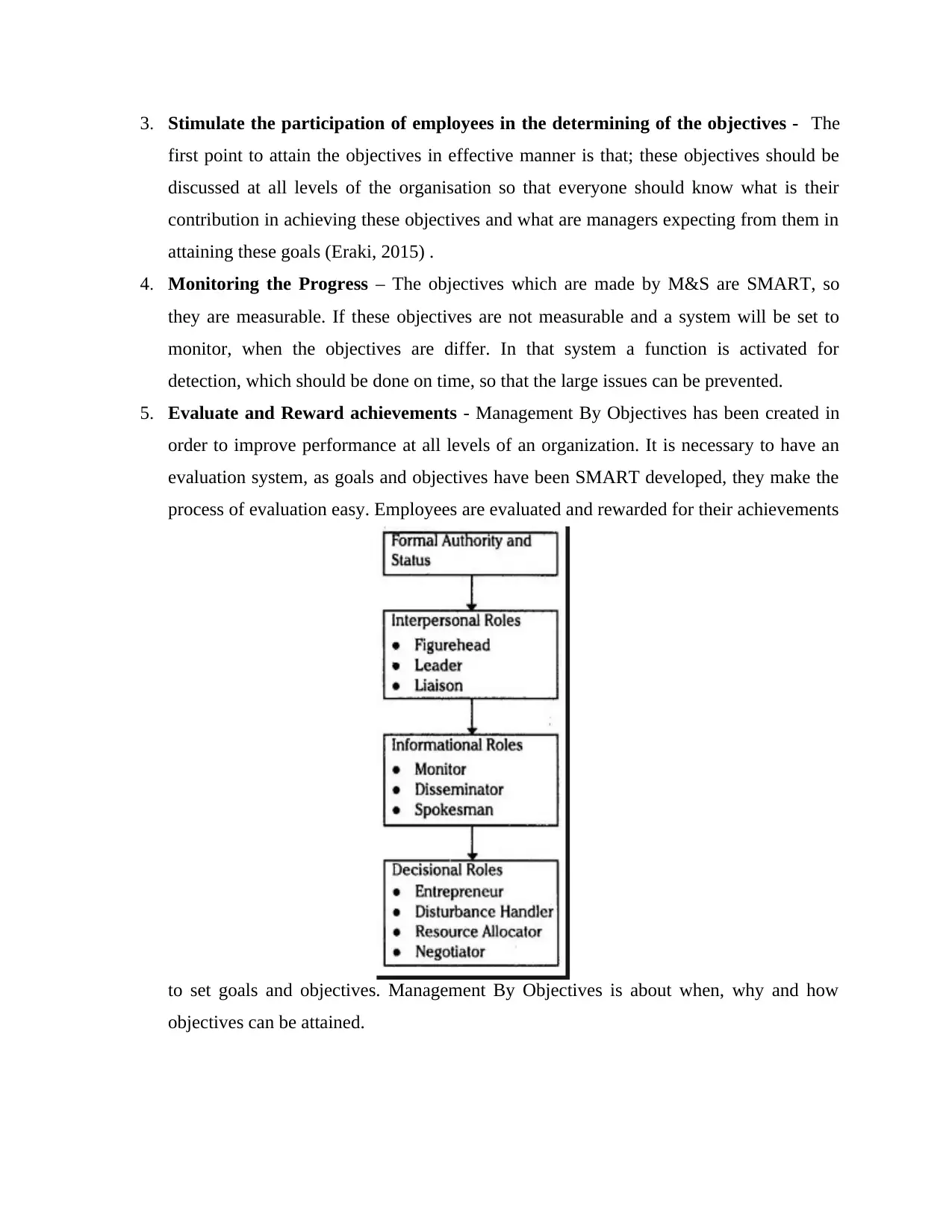
3. Stimulate the participation of employees in the determining of the objectives - The
first point to attain the objectives in effective manner is that; these objectives should be
discussed at all levels of the organisation so that everyone should know what is their
contribution in achieving these objectives and what are managers expecting from them in
attaining these goals (Eraki, 2015) .
4. Monitoring the Progress – The objectives which are made by M&S are SMART, so
they are measurable. If these objectives are not measurable and a system will be set to
monitor, when the objectives are differ. In that system a function is activated for
detection, which should be done on time, so that the large issues can be prevented.
5. Evaluate and Reward achievements - Management By Objectives has been created in
order to improve performance at all levels of an organization. It is necessary to have an
evaluation system, as goals and objectives have been SMART developed, they make the
process of evaluation easy. Employees are evaluated and rewarded for their achievements
to set goals and objectives. Management By Objectives is about when, why and how
objectives can be attained.
first point to attain the objectives in effective manner is that; these objectives should be
discussed at all levels of the organisation so that everyone should know what is their
contribution in achieving these objectives and what are managers expecting from them in
attaining these goals (Eraki, 2015) .
4. Monitoring the Progress – The objectives which are made by M&S are SMART, so
they are measurable. If these objectives are not measurable and a system will be set to
monitor, when the objectives are differ. In that system a function is activated for
detection, which should be done on time, so that the large issues can be prevented.
5. Evaluate and Reward achievements - Management By Objectives has been created in
order to improve performance at all levels of an organization. It is necessary to have an
evaluation system, as goals and objectives have been SMART developed, they make the
process of evaluation easy. Employees are evaluated and rewarded for their achievements
to set goals and objectives. Management By Objectives is about when, why and how
objectives can be attained.
Paraphrase This Document
Need a fresh take? Get an instant paraphrase of this document with our AI Paraphraser
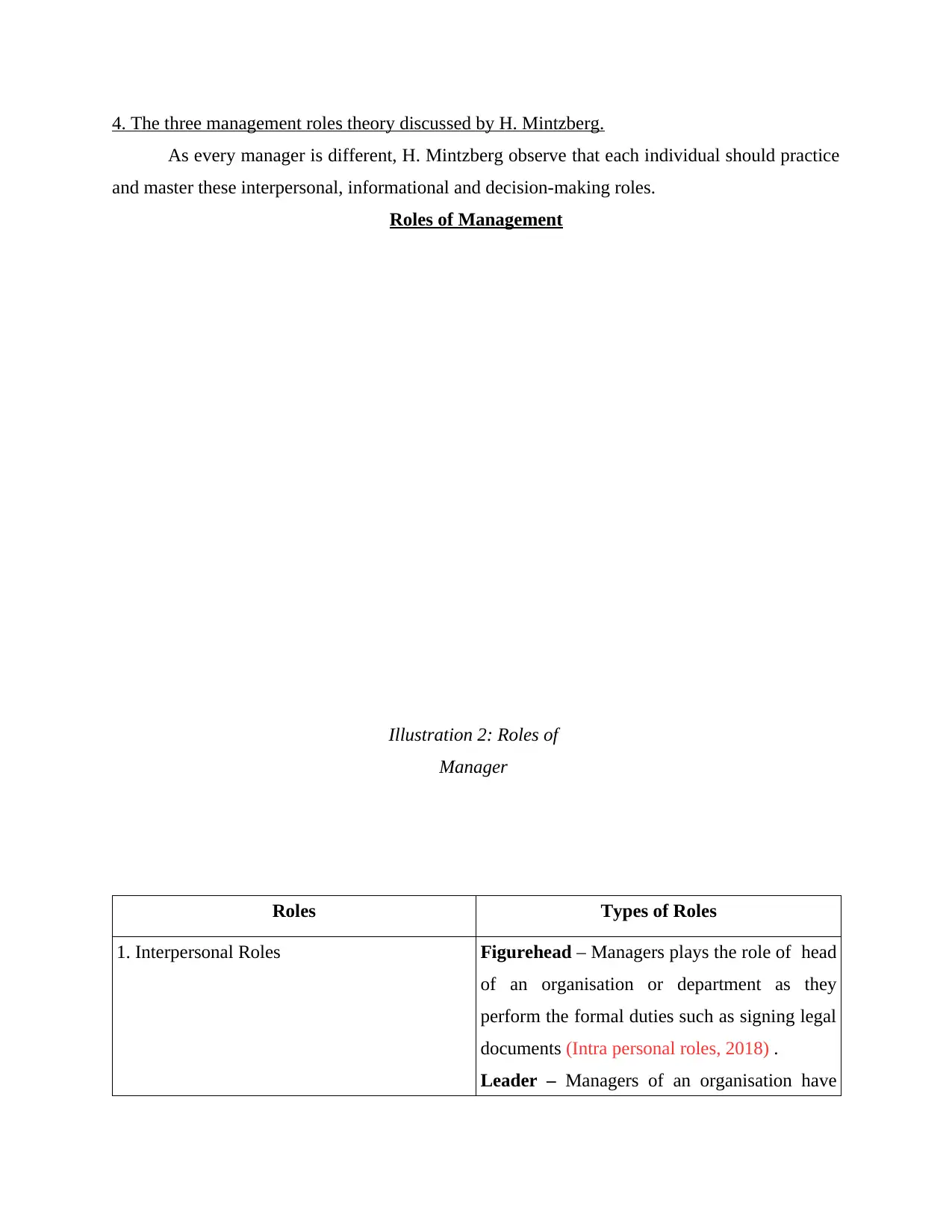
4. The three management roles theory discussed by H. Mintzberg.
As every manager is different, H. Mintzberg observe that each individual should practice
and master these interpersonal, informational and decision-making roles.
Roles of Management
Roles Types of Roles
1. Interpersonal Roles Figurehead – Managers plays the role of head
of an organisation or department as they
perform the formal duties such as signing legal
documents (Intra personal roles, 2018) .
Leader – Managers of an organisation have
Illustration 2: Roles of
Manager
As every manager is different, H. Mintzberg observe that each individual should practice
and master these interpersonal, informational and decision-making roles.
Roles of Management
Roles Types of Roles
1. Interpersonal Roles Figurehead – Managers plays the role of head
of an organisation or department as they
perform the formal duties such as signing legal
documents (Intra personal roles, 2018) .
Leader – Managers of an organisation have
Illustration 2: Roles of
Manager
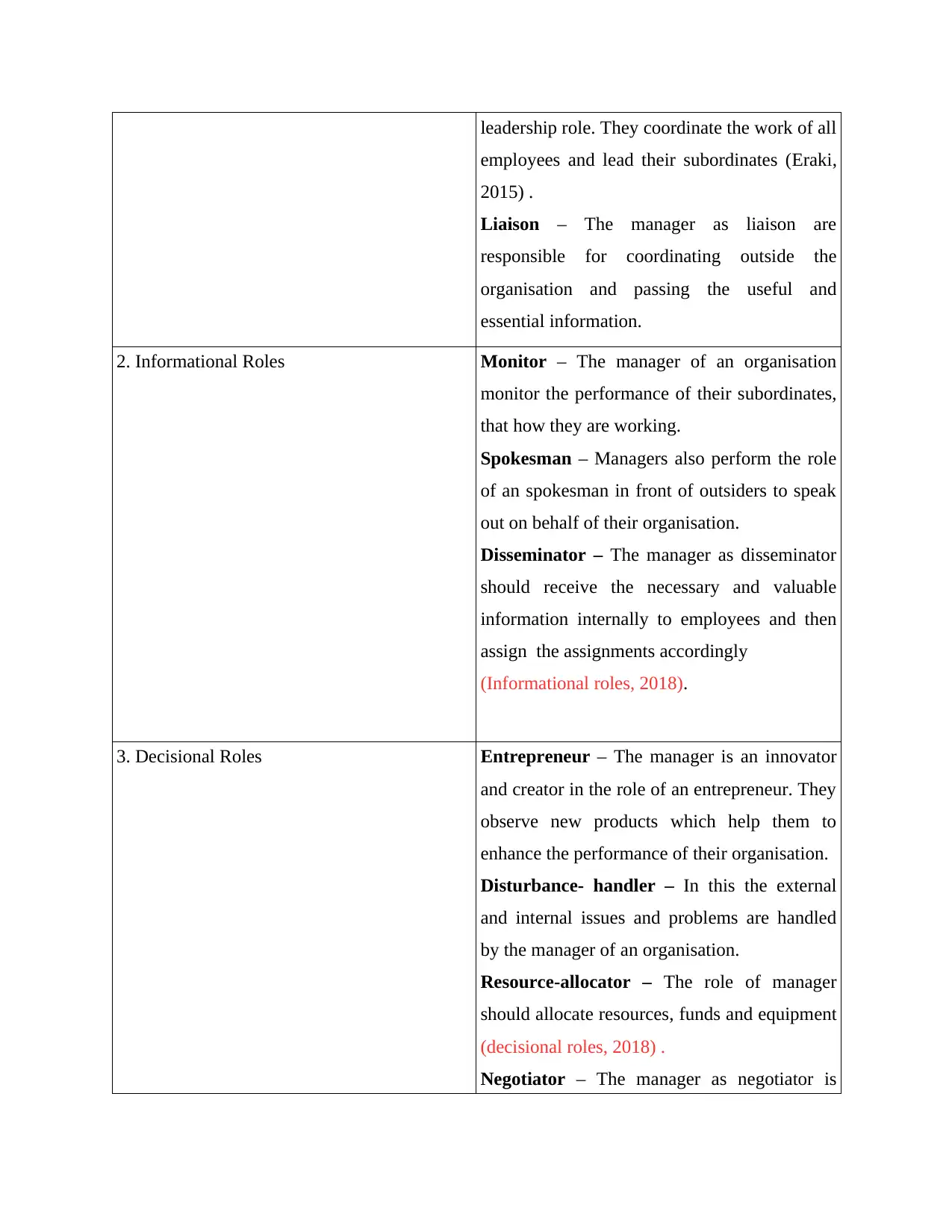
leadership role. They coordinate the work of all
employees and lead their subordinates (Eraki,
2015) .
Liaison – The manager as liaison are
responsible for coordinating outside the
organisation and passing the useful and
essential information.
2. Informational Roles Monitor – The manager of an organisation
monitor the performance of their subordinates,
that how they are working.
Spokesman – Managers also perform the role
of an spokesman in front of outsiders to speak
out on behalf of their organisation.
Disseminator – The manager as disseminator
should receive the necessary and valuable
information internally to employees and then
assign the assignments accordingly
(Informational roles, 2018).
3. Decisional Roles Entrepreneur – The manager is an innovator
and creator in the role of an entrepreneur. They
observe new products which help them to
enhance the performance of their organisation.
Disturbance- handler – In this the external
and internal issues and problems are handled
by the manager of an organisation.
Resource-allocator – The role of manager
should allocate resources, funds and equipment
(decisional roles, 2018) .
Negotiator – The manager as negotiator is
employees and lead their subordinates (Eraki,
2015) .
Liaison – The manager as liaison are
responsible for coordinating outside the
organisation and passing the useful and
essential information.
2. Informational Roles Monitor – The manager of an organisation
monitor the performance of their subordinates,
that how they are working.
Spokesman – Managers also perform the role
of an spokesman in front of outsiders to speak
out on behalf of their organisation.
Disseminator – The manager as disseminator
should receive the necessary and valuable
information internally to employees and then
assign the assignments accordingly
(Informational roles, 2018).
3. Decisional Roles Entrepreneur – The manager is an innovator
and creator in the role of an entrepreneur. They
observe new products which help them to
enhance the performance of their organisation.
Disturbance- handler – In this the external
and internal issues and problems are handled
by the manager of an organisation.
Resource-allocator – The role of manager
should allocate resources, funds and equipment
(decisional roles, 2018) .
Negotiator – The manager as negotiator is
⊘ This is a preview!⊘
Do you want full access?
Subscribe today to unlock all pages.

Trusted by 1+ million students worldwide
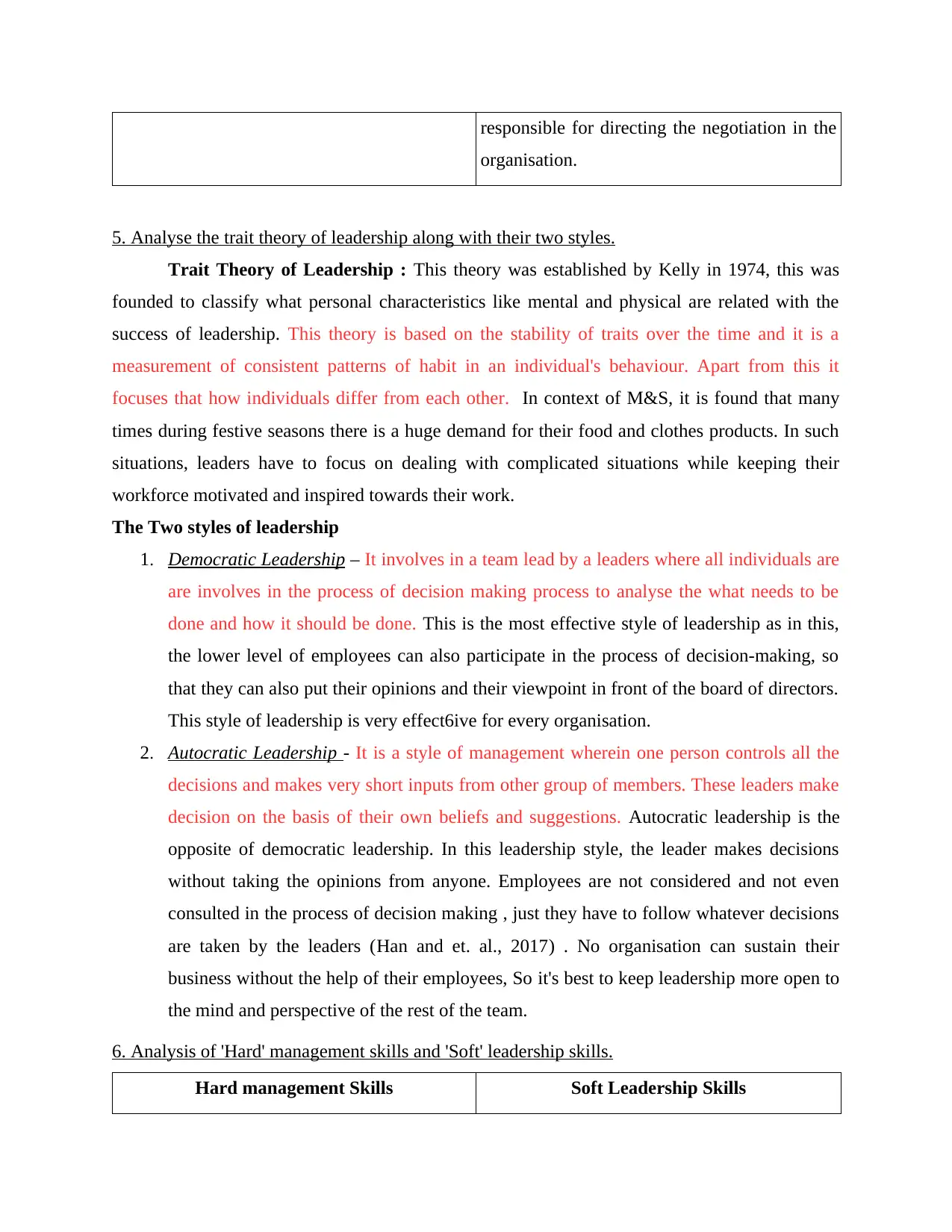
responsible for directing the negotiation in the
organisation.
5. Analyse the trait theory of leadership along with their two styles.
Trait Theory of Leadership : This theory was established by Kelly in 1974, this was
founded to classify what personal characteristics like mental and physical are related with the
success of leadership. This theory is based on the stability of traits over the time and it is a
measurement of consistent patterns of habit in an individual's behaviour. Apart from this it
focuses that how individuals differ from each other. In context of M&S, it is found that many
times during festive seasons there is a huge demand for their food and clothes products. In such
situations, leaders have to focus on dealing with complicated situations while keeping their
workforce motivated and inspired towards their work.
The Two styles of leadership
1. Democratic Leadership – It involves in a team lead by a leaders where all individuals are
are involves in the process of decision making process to analyse the what needs to be
done and how it should be done. This is the most effective style of leadership as in this,
the lower level of employees can also participate in the process of decision-making, so
that they can also put their opinions and their viewpoint in front of the board of directors.
This style of leadership is very effect6ive for every organisation.
2. Autocratic Leadership - It is a style of management wherein one person controls all the
decisions and makes very short inputs from other group of members. These leaders make
decision on the basis of their own beliefs and suggestions. Autocratic leadership is the
opposite of democratic leadership. In this leadership style, the leader makes decisions
without taking the opinions from anyone. Employees are not considered and not even
consulted in the process of decision making , just they have to follow whatever decisions
are taken by the leaders (Han and et. al., 2017) . No organisation can sustain their
business without the help of their employees, So it's best to keep leadership more open to
the mind and perspective of the rest of the team.
6. Analysis of 'Hard' management skills and 'Soft' leadership skills.
Hard management Skills Soft Leadership Skills
organisation.
5. Analyse the trait theory of leadership along with their two styles.
Trait Theory of Leadership : This theory was established by Kelly in 1974, this was
founded to classify what personal characteristics like mental and physical are related with the
success of leadership. This theory is based on the stability of traits over the time and it is a
measurement of consistent patterns of habit in an individual's behaviour. Apart from this it
focuses that how individuals differ from each other. In context of M&S, it is found that many
times during festive seasons there is a huge demand for their food and clothes products. In such
situations, leaders have to focus on dealing with complicated situations while keeping their
workforce motivated and inspired towards their work.
The Two styles of leadership
1. Democratic Leadership – It involves in a team lead by a leaders where all individuals are
are involves in the process of decision making process to analyse the what needs to be
done and how it should be done. This is the most effective style of leadership as in this,
the lower level of employees can also participate in the process of decision-making, so
that they can also put their opinions and their viewpoint in front of the board of directors.
This style of leadership is very effect6ive for every organisation.
2. Autocratic Leadership - It is a style of management wherein one person controls all the
decisions and makes very short inputs from other group of members. These leaders make
decision on the basis of their own beliefs and suggestions. Autocratic leadership is the
opposite of democratic leadership. In this leadership style, the leader makes decisions
without taking the opinions from anyone. Employees are not considered and not even
consulted in the process of decision making , just they have to follow whatever decisions
are taken by the leaders (Han and et. al., 2017) . No organisation can sustain their
business without the help of their employees, So it's best to keep leadership more open to
the mind and perspective of the rest of the team.
6. Analysis of 'Hard' management skills and 'Soft' leadership skills.
Hard management Skills Soft Leadership Skills
Paraphrase This Document
Need a fresh take? Get an instant paraphrase of this document with our AI Paraphraser
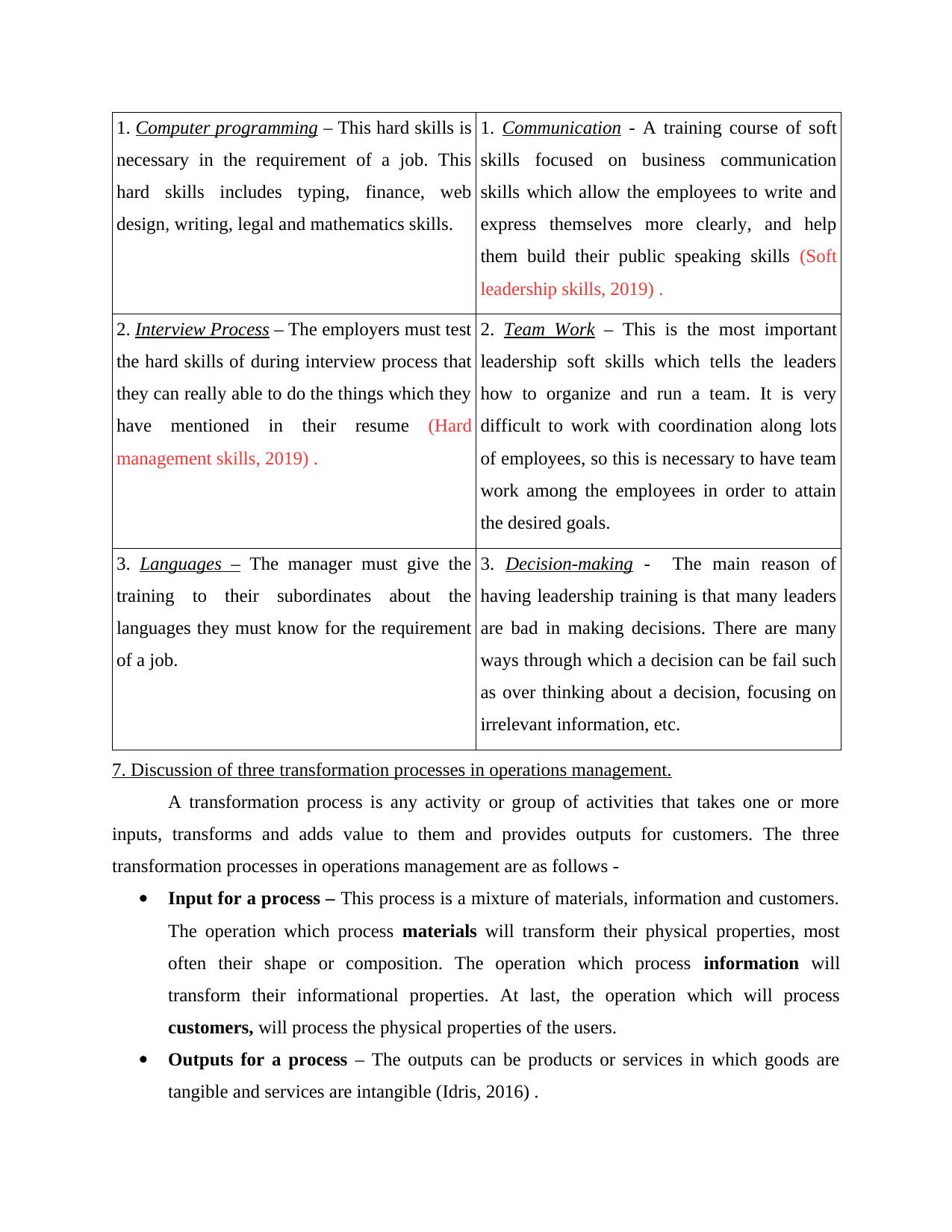
1. Computer programming – This hard skills is
necessary in the requirement of a job. This
hard skills includes typing, finance, web
design, writing, legal and mathematics skills.
1. Communication - A training course of soft
skills focused on business communication
skills which allow the employees to write and
express themselves more clearly, and help
them build their public speaking skills (Soft
leadership skills, 2019) .
2. Interview Process – The employers must test
the hard skills of during interview process that
they can really able to do the things which they
have mentioned in their resume (Hard
management skills, 2019) .
2. Team Work – This is the most important
leadership soft skills which tells the leaders
how to organize and run a team. It is very
difficult to work with coordination along lots
of employees, so this is necessary to have team
work among the employees in order to attain
the desired goals.
3. Languages – The manager must give the
training to their subordinates about the
languages they must know for the requirement
of a job.
3. Decision-making - The main reason of
having leadership training is that many leaders
are bad in making decisions. There are many
ways through which a decision can be fail such
as over thinking about a decision, focusing on
irrelevant information, etc.
7. Discussion of three transformation processes in operations management.
A transformation process is any activity or group of activities that takes one or more
inputs, transforms and adds value to them and provides outputs for customers. The three
transformation processes in operations management are as follows -
Input for a process – This process is a mixture of materials, information and customers.
The operation which process materials will transform their physical properties, most
often their shape or composition. The operation which process information will
transform their informational properties. At last, the operation which will process
customers, will process the physical properties of the users.
Outputs for a process – The outputs can be products or services in which goods are
tangible and services are intangible (Idris, 2016) .
necessary in the requirement of a job. This
hard skills includes typing, finance, web
design, writing, legal and mathematics skills.
1. Communication - A training course of soft
skills focused on business communication
skills which allow the employees to write and
express themselves more clearly, and help
them build their public speaking skills (Soft
leadership skills, 2019) .
2. Interview Process – The employers must test
the hard skills of during interview process that
they can really able to do the things which they
have mentioned in their resume (Hard
management skills, 2019) .
2. Team Work – This is the most important
leadership soft skills which tells the leaders
how to organize and run a team. It is very
difficult to work with coordination along lots
of employees, so this is necessary to have team
work among the employees in order to attain
the desired goals.
3. Languages – The manager must give the
training to their subordinates about the
languages they must know for the requirement
of a job.
3. Decision-making - The main reason of
having leadership training is that many leaders
are bad in making decisions. There are many
ways through which a decision can be fail such
as over thinking about a decision, focusing on
irrelevant information, etc.
7. Discussion of three transformation processes in operations management.
A transformation process is any activity or group of activities that takes one or more
inputs, transforms and adds value to them and provides outputs for customers. The three
transformation processes in operations management are as follows -
Input for a process – This process is a mixture of materials, information and customers.
The operation which process materials will transform their physical properties, most
often their shape or composition. The operation which process information will
transform their informational properties. At last, the operation which will process
customers, will process the physical properties of the users.
Outputs for a process – The outputs can be products or services in which goods are
tangible and services are intangible (Idris, 2016) .
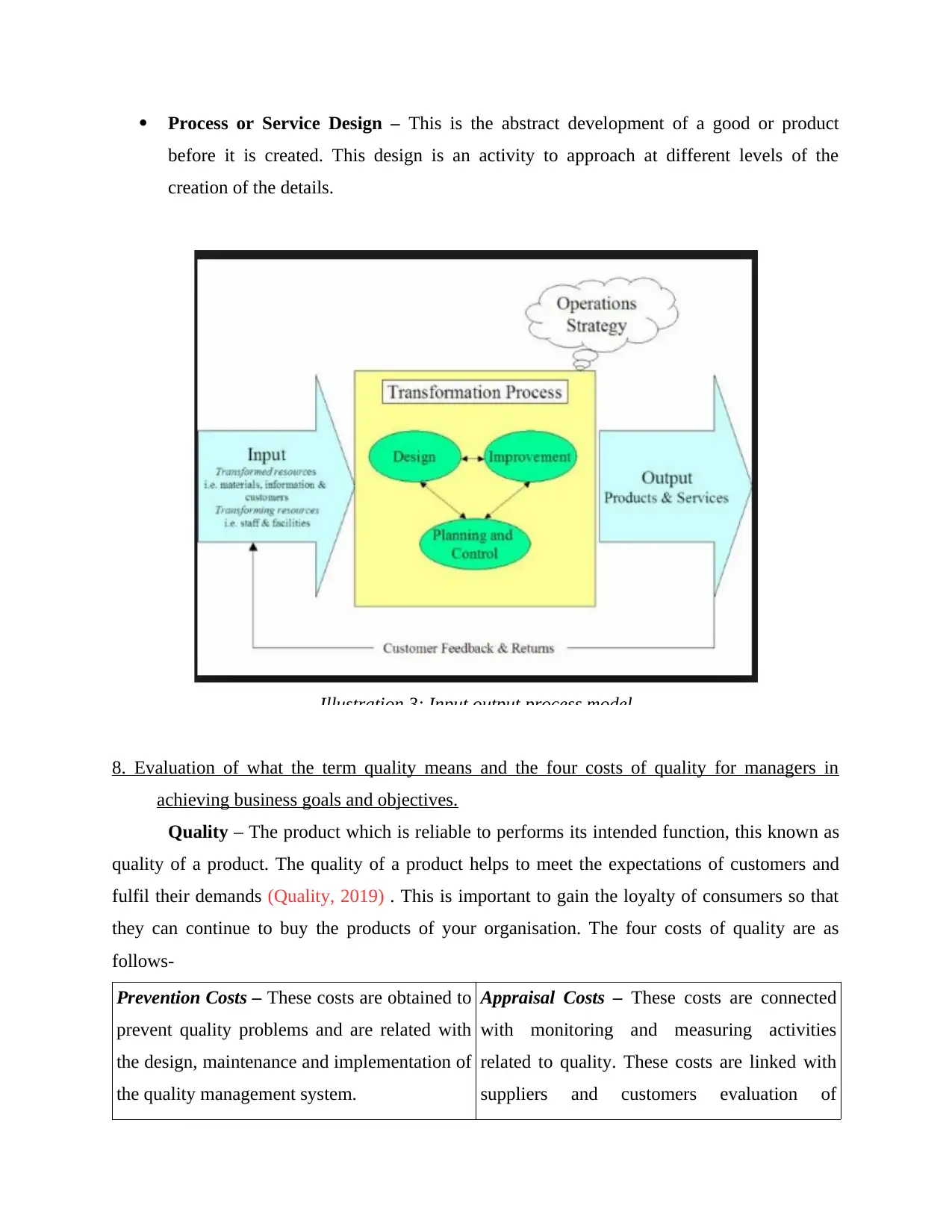
Process or Service Design – This is the abstract development of a good or product
before it is created. This design is an activity to approach at different levels of the
creation of the details.
8. Evaluation of what the term quality means and the four costs of quality for managers in
achieving business goals and objectives.
Quality – The product which is reliable to performs its intended function, this known as
quality of a product. The quality of a product helps to meet the expectations of customers and
fulfil their demands (Quality, 2019) . This is important to gain the loyalty of consumers so that
they can continue to buy the products of your organisation. The four costs of quality are as
follows-
Prevention Costs – These costs are obtained to
prevent quality problems and are related with
the design, maintenance and implementation of
the quality management system.
Appraisal Costs – These costs are connected
with monitoring and measuring activities
related to quality. These costs are linked with
suppliers and customers evaluation of
Illustration 3: Input output process model
before it is created. This design is an activity to approach at different levels of the
creation of the details.
8. Evaluation of what the term quality means and the four costs of quality for managers in
achieving business goals and objectives.
Quality – The product which is reliable to performs its intended function, this known as
quality of a product. The quality of a product helps to meet the expectations of customers and
fulfil their demands (Quality, 2019) . This is important to gain the loyalty of consumers so that
they can continue to buy the products of your organisation. The four costs of quality are as
follows-
Prevention Costs – These costs are obtained to
prevent quality problems and are related with
the design, maintenance and implementation of
the quality management system.
Appraisal Costs – These costs are connected
with monitoring and measuring activities
related to quality. These costs are linked with
suppliers and customers evaluation of
Illustration 3: Input output process model
⊘ This is a preview!⊘
Do you want full access?
Subscribe today to unlock all pages.

Trusted by 1+ million students worldwide
1 out of 21
Related Documents
Your All-in-One AI-Powered Toolkit for Academic Success.
+13062052269
info@desklib.com
Available 24*7 on WhatsApp / Email
![[object Object]](/_next/static/media/star-bottom.7253800d.svg)
Unlock your academic potential
Copyright © 2020–2025 A2Z Services. All Rights Reserved. Developed and managed by ZUCOL.




